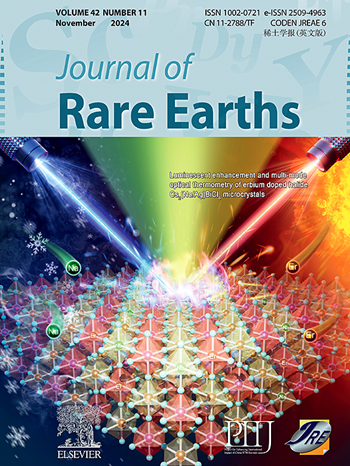Formation mechanism of high-temperature oxidation film on WE43 magnesium alloy and its effect on corrosion performance
IF 5.2
1区 化学
Q1 CHEMISTRY, APPLIED
引用次数: 0
Abstract
The oxidation behavior of WE43 magnesium alloy in dry air at three temperatures (225, 440 and 525 °C) and the corresponding corrosion performance of samples attached to oxide film in 3.5 wt% NaCl solution was investigated. The results show that the oxide films formed at all three temperatures are a complex MgO·RE2O3·ZrO film with different compositions. The film formed at 225 °C is flat and dense, whose components are 3.2MgO·1.8RE2O3·1ZrO. The oxidation ridges begin to form, and then gradually grow into nodular oxides and form a loose and porous oxide layer as the temperature increases to 525 °C. The oxide films formed at all three temperatures improve the corrosion resistance of the alloy due to the MgO·RE2O3·ZrO, with the protective properties of oxide films following the order of 225 °C > 440 °C > 525 °C, because the dense MgO·RE2O3·ZrO film formed at 225 °C can provide better protection to the substrate than the loose oxide film formed at higher temperatures.

WE43 镁合金高温氧化膜的形成机理及其对腐蚀性能的影响
研究了 WE43 镁合金在干燥空气中三种温度(225、440 和 525 °C)下的氧化行为以及样品在 3.5 wt% NaCl 溶液中附着氧化膜的相应腐蚀性能。结果表明,在所有三个温度下形成的氧化膜都是成分不同的复合 MgO-RE2O3-ZrO 膜。225 °C 时形成的薄膜平整致密,其成分为 3.2MgO-1.8RE2O3-1ZrO。氧化脊开始形成,然后随着温度升高到 525 ℃,逐渐长成结核状氧化物,并形成疏松多孔的氧化层。由于 MgO-RE2O3-ZrO 的作用,在这三种温度下形成的氧化膜都能提高合金的耐腐蚀性,氧化膜的保护性能依次为 225 °C > 440 °C > 525 °C,这是因为在 225 °C 下形成的致密 MgO-RE2O3-ZrO 膜比在更高温度下形成的疏松氧化膜能更好地保护基体。
本文章由计算机程序翻译,如有差异,请以英文原文为准。
求助全文
约1分钟内获得全文
求助全文
来源期刊

Journal of Rare Earths
化学-应用化学
CiteScore
8.70
自引率
14.30%
发文量
374
审稿时长
1.7 months
期刊介绍:
The Journal of Rare Earths reports studies on the 17 rare earth elements. It is a unique English-language learned journal that publishes works on various aspects of basic theory and applied science in the field of rare earths (RE). The journal accepts original high-quality original research papers and review articles with inventive content, and complete experimental data. It represents high academic standards and new progress in the RE field. Due to the advantage of abundant RE resources of China, the research on RE develops very actively, and papers on the latest progress in this field emerge every year. It is not only an important resource in which technicians publish and obtain their latest research results on RE, but also an important way of reflecting the updated progress in RE research field.
The Journal of Rare Earths covers all research and application of RE rare earths including spectroscopy, luminescence and phosphors, rare earth catalysis, magnetism and magnetic materials, advanced rare earth materials, RE chemistry & hydrometallurgy, RE metallography & pyrometallurgy, RE new materials, RE solid state physics & solid state chemistry, rare earth applications, RE analysis & test, RE geology & ore dressing, etc.
 求助内容:
求助内容: 应助结果提醒方式:
应助结果提醒方式:


